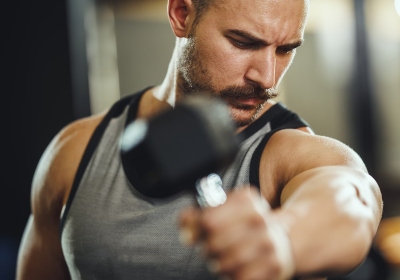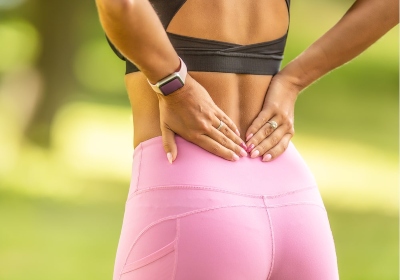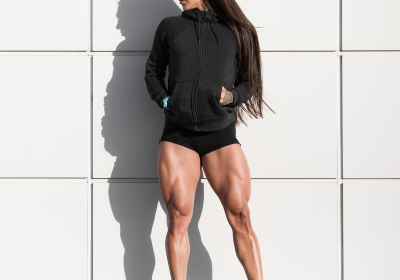VIDEO
Dumbbell Goblet Squat
- Upper Back
- Lower Back
- Shoulders
- Gluteus
- Quads
- Hamstrings
Level:Beginner
Trainer:Nick Taylor
Equipment:Dumbbell
Dumbbell Goblet Squat
- Upper Back
- Lower Back
- Shoulders
- Gluteus
- Quads
- Hamstrings
Level:Beginner
Trainer:Nick Taylor
Equipment:Dumbbell
Hold dumbbell by one side close to your chest in standing position. Squat down with legs slightly more than shoulder width apart while holding dumbbell close to the chest. Squat until your hamstrings touch your calves, making sure to keep your back straight. Make a pause at the bottom and push back to standing position.
save to ...
RECOMMENDED FOR YOU
ARTICLES
The shoulder muscles are divided into two groups. The anterior group consists of flexors: the coracohumeral, the brachialis, and the biceps brachii. The posterior group includes the extensors: the triceps brachii and ulnar.
The coracohumerals start from the coracoid process of the scapula fuses with the short head of the biceps brachii and pectoralis minor and attaches to the humerus at the level of the upper edge of the brachial.
The brachials start from the lower half of the anterior surface of the humerus and the intermuscular septa of the shoulder and attach to the tuberosity of the ulna and its coronal process.
The biceps brachii has two heads starting on the scapula from the supra-articular tubercle (long head) and the coracoid process (short head). It attaches to the forearm to the tuberosity of the radius and the fascia of the forearm. It belongs to the bicarticular part. Concerning the shoulder joint, the biceps of the shoulder is the flexor of the shoulder, and the elbow is the flexor and instep support of the forearm.
The triceps brachii is located on the back of the shoulder, has three heads, and is a bicarticular. It participates in the movements of both the shoulder and the forearm, causing extension and adduction in the shoulder joint and extension in the elbow.
The ulnar starts from the lateral epicondyle of the humerus and radial collateral ligament and the fascia; it is attached to the upper part of the posterior surface and partly to the olecranon of the ulna in its upper quarter. The function of this is to extend the forearm.
The bundles of the deltoid muscle perform different functions, so it will not work to load them all with one exercise: you will have to include at least three movements in the training. All exercises are divided into three parts: for pumping the front, middle and back beams. Pick exercises from our list below and add them to your workouts. The weight is necessary so that the last repetitions in the approach are given not easily, but without compromising the technique. You can train your shoulder straps both at home and in the gym. But it is necessary to have a bar and a gantry. Weight must be chosen in such a way that in every set it was possible to raise the average 8-10 times. This is how you can increase the volume and mass. If the same goal is set - to increase the strength, to train in the face of more severe conditions. In this case, the number of repeats will be 5-8. The number of reps is 4-5.
Barbell bench press. Take the shell on your chest, bring your elbows forward, tighten your abs, buttocks, legs. Squeeze the bar up, lower it back and repeat. When the bar passes your face, do not lift your chin, but squeeze it in yourself: this way the bar will go along the optimal trajectory. If the projectile remains in front of the body at the top point, and not above it, the load on the lower back increases. Therefore, try to take the barbell behind your head.
Standing dumbbell press. Raise your arms with the selected weight to shoulder level, turn your palms forward with your fingers. Squeeze the dumbbells up and take them slightly behind your head, and then lower them to the starting position and repeat. Do three to five approaches 10-12 times.
Seated Bent-Over Dumbbell Routing. Sit on a bench, tilt your body with a straight back, as far as flexibility allows, hold the dumbbells in your lowered hands. Without changing the position of the body, spread your arms with the taken weight on the sides to shoulder level. Slowly lower the dumbbells to the starting position and repeat.
Read more
Hamstring muscle training is often neglected, but for most athletes, however, it is very important because strong hamstrings help avoid many injuries.
They are a group of powerful muscles that extend from the pelvis to the knee at the back of the upper leg. Their two main roles are to extend the leg (pull it back) and bend the knee, movements we use both in mountain walking or running and in everyday life. We engage and overuse them more than we realize, which creates tension and can lead to acute or chronic injuries due to overuse. For example, when you run or hike up a mountain, it may seem like you are primarily using your quadriceps, but you are also straining your hams, especially if you are overzealous or taking a big step to navigating over rocks or roots.
These muscles consist of three parts: the semi-tendon muscle, the biceps femoris muscle, and the semitendinosus muscle. Together they form a large group of muscles that work at the base of the thigh. Their main function is to bend the leg at the knee joint.
Before performing any strength exercises, it is important to warm up and stretch the hamstring muscles well, because the muscles are often in a contracted condition.
Training
It is better, to begin with, a 5-10 minutes light workout. This can be cycling, running, etc. Such workouts are good for warming up before stretching, after which you can proceed to the main workout. Training cool muscles is not a good idea.
Wise advice for beginner athletes who want to train with extra weight - use a lighter load and more reps at first to gradually develop muscle strength.
There are many exercises that do not directly target your hamstrings, but where they help your hamstrings, such as pull-ups, lunges, and squats. However, to develop them well, it is also important to do some isolation exercises where you focus directly on your hams. To help you on your way, we decided to list the most important exercises below.
Hamstrings Compression helps relieve pain and tightness.
Stretching relieves stress and helps strengthen the ligaments in the back of the knee as well as the hamstrings.
Quadriceps stretching with support. This exercise will strengthen your hams instead of your quadriceps. It also improves knee mobility.
Leg lift with resting on arms. Lifting one leg is aimed at pumping the glutes, as well as strengthening the hamstrings.
Wall Squats. Such squats will strengthen your knees and also reduce pain if any. The exercise works all the muscles that are connected to the knees.
Lunges also engage your hamstrings, glutes, inner thigh muscles, and calves. The strength of these muscles determines the strength of your knees. The stronger they are, the more tension they will absorb, thus preventing injury and pain.
Exercises with a roller are a perfect way to massage and relax your muscles.
Read more
The most important muscles in the upper back are the lats and trapezius.
Lats (Latissimus dorsi). Shaping muscles of the back, giving the figure a tapered appearance. Visually widen the shoulders and make the waist appear narrower. They are located on both sides of the spine, and their shape resembles a wing.
Trapezius muscles. These are the muscles that need to be trained if you want to correct the slouch. Responsible for the movement of the scapula. They have a triangular shape; in the upper part, they are attached to the back of the head, in the lower part - to the spine.
Be careful, ‘cos back exercises are some of the most traumatic. In the early stages, use light weights to strengthen the ligaments and muscles to protect the spine. After mastering the technique, gradually and very gently increase the weight.
The upper and horizontal rows are the exercises closest to the anatomical movement of the joints.
Training
Wide grip pull-ups. Pulling up is one of the main exercises for back muscle growth, performed with body weight. First, learn how to pull up correctly, and only then move on to training with dumbbells or a barbell. It is important that when performing the exercise, you should feel the work of the back muscles, not the biceps. Grab the horizontal bar with an upper grip, arms slightly wider than shoulder-width. When pulling up, try to pull the body up not with your hands, but with your back. Pause for a second at the top point, smoothly return to the starting position.
Upper block thrust. The exercise imitates pulling up, go to it only when you learn to pull up, and you can do it at least 8-10 times per set. Important: pulling the bar towards your chest, not your head - this will reduce the dangerous load on your shoulders, a signal of improper performance - to feel the work of the hands. If you can't feel your back, use less weight. increase the width of the grip every time - this has a positive effect on the 'growth' of the back.
Seated pulldown. A basic exercise that includes a large muscle mass, especially the pectorals and lats. One of the best for giving the back a visual width. With a straight bar (see photo), the trapezius muscles are also included in the work.
Make sure that the cable is parallel to the floor during the exercise, the torso does not change the slope, and the back is straight.
Shrugs. Almost the only exercise for isolated work on the trapezius muscles. There are many variations - with dumbbells, with a barbell, standing, sitting or lying down. The photo shows an option sitting on a bench with dumbbells.
When lifting the dumbbells up, you can lower your chin slightly, which will increase the load on the muscles. It is important not to rotate your shoulders or relax them at the bottom of the exercise - this is very dangerous for the joints.
One-arm dumbbell row. Place your knee and hand on the bench. Take the dumbbell with your other hand, pull it as close to your chest as possible, then slowly lower it down. Make sure that your back is parallel to the floor during the exercise, do not round it; do not drop your non-working shoulder.
Important:
As soon as the elbow is at shoulder level, connect the shoulder to the movement - pull it up with the elbow. This will maximize the contraction of your mid-back and upper lats.
If you are having trouble getting your elbow higher than your shoulder, use a lighter dumbbell.
Read more
Your lower back includes the 5 vertebral bones that are placed on top of each other with intervertebral discs. The bones are connected there using unique joints. The lumbar spine is matched with the thoracic region above and the thighs below.
Individual anatomical structures include :
Vertebrae. It protects important nerve tissues such as the spinal cord and cauda equina.
Disks. The discs usually provide cushioning and cushioning to protect the vertebrae during spinal movements.
Facet joints give a little stability and allow the spine to move in various directions. The facets of the upper lumbar vertebrae are almost the same as the facet joints of the chest and, as it was already written, the main aim is controlling the movement of the spine.
The facets of the lumbar are more flexible and facilitate side-to-side movement.
The large muscles and complex network of ligaments support serve to stabilize it and enhance your twisting and bending movements.
The lumbar supports most of the body. A lot of people feel this kind of pain at some point sometimes. Sedentary muscle atrophy is common, especially if you work in an office and lead a relatively sedentary lifestyle. If you want to make your lower back stronger, start with a regular training program that consists of strength training, stretching, and aerobics or cardiovascular exercise.
Training
Child's pose. Get on all fours and stretch your arms out in front of you. Gently lower your buttocks to your heels. Lower your head to the floor and push your palms forward until your arms are fully extended. Stay in this position for 30 seconds.
Lunges. Lunge with your right foot forward, rest on your hands. Please note that the right hand should be to the left of the leg. Step your right foot about the width of your right hand. Next, without moving your arms, swing your hips forward to stretch the front of the thighs, and hold in this position for 30 seconds. Do the same with the other leg.
Seated crunches. Sit with your legs straight, then bend your knees and bring your left leg over your right, placing it on the outside of your right thigh. Pull your right foot closer to your right buttock. Next, bend your right arm at the elbow and put it behind your left knee, as if keeping yourself twisted. Hold this position for 30 seconds. and repeat the same for the other leg.
Happy child. Lie on the floor, as you exhale, pull your knees to your stomach. As you inhale, grab the outer sides of your feet with your hands. Slightly spread the knees to the sides slightly wider than the body, pull the knees to the armpits. Make sure your shins are perpendicular to the floor. Hold this pose for 30 seconds.
Twisting. Lie on the floor and bend your knees, take your legs to the side, for example to the right. In this case, the left leg should lie on the floor, and the right ankle should be above the left knee. Place your hands next to your head, with your right knee strive downward (to the floor). Stay in this position for 30 seconds. alternately for each side.
Read more
One of the most important running muscles is the quadriceps - the large muscle at the front of the thigh. It has been scientifically proven that regular strength training improves workout performance and reduces the risk of injury, as well as strengthens your back, and leg muscles, making your running more productive.
The quads, also known as the quadriceps muscle, is a group of muscles located at the front of the leg above the knee. It is one of the largest and strongest muscles in your body that consists of four heads: fastus medialis (medial wide), vastus intermedius (intermediate wide), vastus lateralis (lateral), and rectus femoris (straight thigh muscle). Almost every action performed by the legs involves two or more heads of the quadriceps. The quadriceps muscle plays an important role at the beginning of the movement (quick start) and during ascent and descent in elevated positions - which is why you may experience painful sensations in this area of the leg after an intense uphill workout.
According to researchers at the University of Delaware, strong quadriceps act as cushioning and can protect the knees and the entire musculature of the hip from common running injuries. Often many runners are injured because they have weak and underdeveloped quadriceps, so it is especially important to strengthen them.
By training and strengthening the quads, you can get the following benefits when running:
Increased speed. Strong quadriceps help you tackle steep hills and climbs more easily and make pushing off the ground more powerful, resulting in increased speed.
Reduced injuries. According to research, poorly developed quadriceps are often associated with many running injuries. For example, a common injury such as the 'runner`s knee' results from weakness in these muscles, which are unable to stabilize the knee joint during the movement.
Increased endurance. Strengthening the quadriceps muscle will make your running more effortless and efficient, which contributes to increased running volume and endurance.
Training
The quadriceps occupy 70% of the muscle mass of the leg, so it is their development that is fundamental in leg training. The main exercise for developing the quadriceps is the squat. But, for beginners, at the first stages of training, it is better to start with leg curls sitting in an exercise machine, leg press, and hyperextensions to strengthen the lower back, to avoid injuries, in order to prepare the base for the heavy squats. It is a good idea to include squats in your training plan after about six months of training.
Read more
SAVE TO ...





